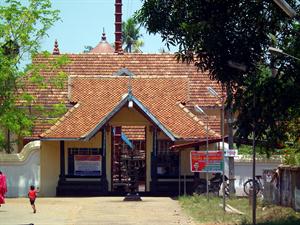Lakshmana Perumal Temple at Thirumoozhikkulam
Lakshmana Perumal Temple at Thirumoozhikkulam is one of the four temples that devotees visit in the month of Karkidakam as part of the sacred Nalambalam Thozhal pilgrimage. Since Lakshmana is the third of the four sons of Dasaratha, this is the third temple to visit. You can read more about Nalambalam thozhal here.

The Lakshmana Perumal Temple at Moozhikkulam
While the other three temples – Triprayar Sree Rama Swami Temple, Iringalakkuda Kootalmanikyam Bharata Temple and Payyammal Shatrughna Temple – are in the Thrissur district, Lakshmana’s temple is in the Ernakulam district. Thirumoozhikkulam lies somewhat in the middle of Aluva in Ernamkulam and Mala in Thrissur. The temple is only about 5 kilometers from the historically important Annamanada Mahadeva Temple.
Temple legend
Several centuries ago, Thirumoozhikkulam was basically jungle with no human settlements. Sage Haritha, a devotee of Vishnu, is believed to have observed severe austerities here for a long time. Vishnu was impressed with his austerity and appeared before him one day on the banks of Poorna River. Vishnu also explained the rituals and deeds that devotees should perform to obtain peace and salvation in Kali Yuga. The place where Lord imparted divine knowledge (thirumozhi) to his devotee eventually came to be known as Thirumoozhikkulam.

Poorna River – The place on the banks of the Poorna River where Lord Vishnu imparted divine knowledge to his devotee sage Haritha eventually came to be known as Thirumoozhikkulam.
In ancient times, the Lakshmana Perumal temple used to receive a lot of Vishnu devotees from Tamil Nadu. Religious or other decisions taken here used to be accepted by other temples in Kerala. Such was its prominence that it was considered as the most important among the four Thali temples patronized by kings of the Chera dynasty.
Nowadays Thirumoozhikkulam sees a massive influx of devotees during the month of Karkidakam. The temple is less crowded during other months. Lakshmana here is known as Thirumoozhikkulathappan. While it is easy to please him, he is known to subject insincere devotees to severe trials and tribulations before showering his blessings on them. Main offerings are Kadalippazham (a kind of small bananas native to Kerala) and palpayasam (kheer made of milk, sugar and rice). Thirumoozhikkulathappan is known to bless his devotees with good progeny, health and longevity. Those afflicted with the wrath of serpents also get relief after praying here.
The life-sized idol of Lakshmana Perumal is installed in the inner sanctum. This idol is similar to the idols found in Triprayar and Koodal Manikkyam temples. Thirumoozhikkulam Temple is one of the 108 Vaishnava Temples in Kerala. In addition to Lakshmana, the temple has dedicated shrines to Dakshinamoorthi Shivan, Ganapathi, Sree Ram and Sita. The outer sanctum has shrines dedicated to Dharma Sastha and Bhagavathi (Mother Goddess). The Goddess is believed to be Urmmila, the consort of Lakshmana. Unmarried girls seeking a suitable groom offer silk, turmeric powder and palpayasam (milk kheer) to the Goddess. To the north of the sanctum, there is a small shrine to Goshala Krishnan. While circumambulating, devotees should obtain the darshan of Sastha and Goddess and then seek the blessings of Goshala Krishnan before returning to the shrine of Lakshmana.
The temple is open for darshan from 4 to 11 in the morning and 5 to 8 in the evening. Keep in mind that the shrines will remain closed while the priest performs the pooja. Devotees have to wait until the doors open again. Each pooja may last 30 minutes or more.
Temple festival
The temple festival is celebrated in the Malayalam month of Medam (April/May). The festival flag will be hoisted on Attham. The ten day festival will conclude on Thiruonam with ritualistic bathing of the idol in the Poorna River. During the ten days of the festival, the temple organizes a variety of cultural programs. Chakyar Koothu (a temple art form that specializes in sarcasam) is given special importance.